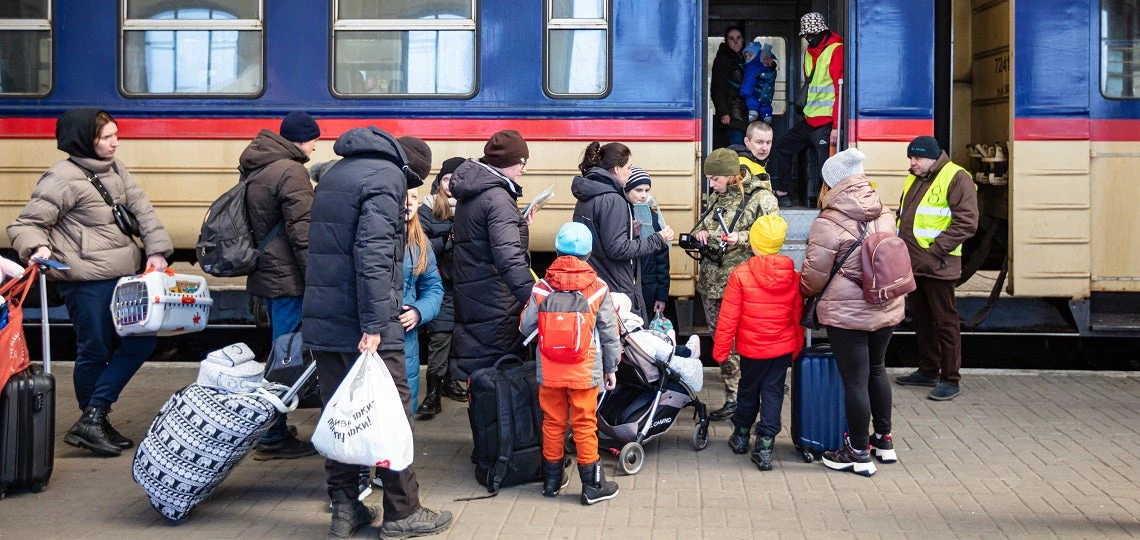 Ukrainian refugees on Lviv railway station waiting for train to escape to Europe
Ukrainian refugees on Lviv railway station waiting for train to escape to Europe
Ukraine and its people continue to suffer from unimaginable loss and devastation caused by the Russian invasion that began on 24 February. The ongoing war has resulted in a major humanitarian crisis that deepens each day, including a mass movement and exodus of Ukraine’s population. More than 4 million refugees to date have entered neighboring countries to escape the war – most of them women and children.
The war is causing severe damage to the economies of Ukraine and the rest of emerging and developing Europe and Central Asia, but the impacts are reverberating far beyond the region to every corner of the globe. The poorest and most vulnerable will be hit hardest. Soaring fertilizer, food and energy prices will lead to greater poverty and hunger for many.
Developing economies neighboring Ukraine and Russia will bear the brunt of the economic crisis. Our latest Economic Update for Europe and Central Asia projects the regional economy will shrink by 4.1 percent in 2022, compared with the pre-war forecast of 3 percent growth. The economic shocks from the war are compounding the ongoing impacts of the COVID-19 pandemic. This would be the second contraction in as many years, and twice as large as the pandemic-induced contraction in 2020.
Ukraine’s economy is expected to shrink by nearly half (around 45 percent) this year, although the magnitude of the contraction will depend on the duration and intensity of the war. And, following an unprecedented level of sanctions, Russia’s economy has plunged into a deep recession with output projected to contract 11.2 percent this year.
Countries in the region were already bracing for a sharp slowdown in 2022 due to a global deceleration in growth and trade, continued COVID-19 disruptions, inflationary pressures, debt sustainability concerns and rising interest rates. The war in Ukraine has compounded these challenges, with the economic impacts being felt through multiple channels, including commodity and financial markets, trade and migration links, remittances, and investor confidence.
Russia, the largest economy in the Europe and Central Asia region, is a major exporter of energy and industrial metals. Russia and Ukraine together supply over 25 percent of world exports of wheat. Europe is particularly dependent on Russian energy, with 47 percent of natural gas and 25 percent of oil imported from Russia. Armenia, Georgia, Kazakhstan and Turkey import over 75 percent of their wheat from Russia and Ukraine, as well many other countries in the Middle East and in Africa. Russia is also a critical export destination for many countries in Eastern Europe, the South Caucasus, and Central Asia, accounting for over 10 percent of their exports.
Moreover, the war and the sanctions have frayed connectivity by disrupting trade routes and increasing shipping and insurance costs, magnifying existing strains on global value chains and impacting a wide range of industries including food, automobile, construction, petrochemical, and transport. Together with higher commodity prices, additional strains on global value chains are further fueling inflationary pressures globally and will have additional impacts on the countries in the region.
The sanctions on Russia are also impacting financial systems in the region and beyond. Continued conflict is likely to further weaken investor confidence and renewed portfolio outflows and currency depreciation in the region.
Remittances from Russia account for close to 30 percent of GDP in some Central Asian countries such as the Kyrgyz Republic and Tajikistan. Russian and Ukrainian tourists are an important source of income for countries such as Turkey, Georgia, Moldova, Montenegro and Poland.
The wave of Ukrainian refugees crossing into Poland, Moldova and Romania requires additional financial resources and humanitarian aid to be swiftly mobilized and basic services delivered to people.
The war will increase poverty in Europe and Central Asia due to the recession and food price inflation. In Ukraine, 6.5 million people are already estimated to be internally displaced and about one-third of the population requires emergency humanitarian assistance.
To support the people of Ukraine, the World Bank Group has mobilized an emergency financing package of more than $925 million to help with continuation of critical government services, including payment of wages for hospital workers, pensions for the elderly, and social programs for the vulnerable. This rapid financing is part of a $3 billion package of support that we are preparing for Ukraine over the coming months.
The immediate effects of conflict are stark, but there are also long-term ramifications for countries, in particular for human capital. Addressing the impacts of humanitarian crises therefore requires both immediate support and long-term development approaches.
To address the economic fallout of the war in Ukraine, countries in the region should pursue policies that support regional integration and connectivity, fortify fiscal and monetary buffers, strengthen government institutions, improve energy efficiency and, first and foremost, improve social safety nets to protect the poorest and most vulnerable in society, including refugees.
At the World Bank Group, we will continue to stand by the people of Ukraine, and all those adversely impacted by the war in the region.



Join the Conversation